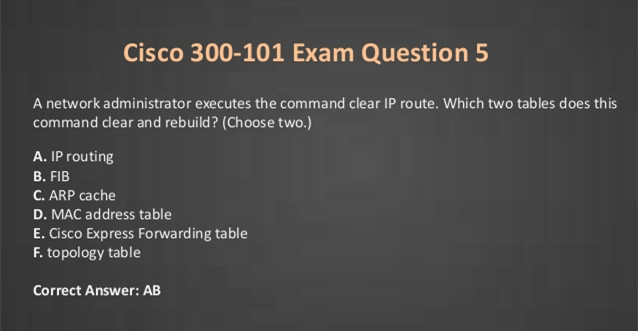Most Popular Cisco 300-101 PDF and Video Exam Preparation Materials
cisco certification 300-101 pdf route questions
cisco certification 300-101 route questions are available. The ROUTE 300-101 exam certifies the routing knowledge and skills of successful candidates. They are certified in using advanced IP addressing and routing in implementing scalable and highly secure Cisco routers that are connected to LANs, WANs, and IPv6.
cisco certification 300-101 pdf route questions objectives are below.
10% 1.0 Network Principles
1.1 Identify Cisco Express Forwarding concepts
1.1.a FIB
1.1.b Adjacency table
1.2 Explain general network challenges
1.2.a Unicast
1.2.b Out-of-order packets
1.2.c Asymmetric routing
1.3 Describe IP operations
1.3.a ICMP Unreachable and Redirects
1.3.b IPv4 and IPv6 fragmentation
1.3.c TTL
1.4 Explain TCP operations
1.4.a IPv4 and IPv6 (P)MTU
1.4.b MSS
1.4.c Latency
1.4.d Windowing
1.4.e Bandwidth-delay product
1.4.f Global synchronization
1.5 Describe UDP operations
1.5.a Starvation
1.5.b Latency
1.6 Recognize proposed changes to the network
1.6.a Changes to routing protocol parameters
1.6.b Migrate parts of the network to IPv6
1.6.c Routing protocol migration
10% 2.0 Layer 2 Technologies
2.1 Configure and verify PPP
2.1.a Authentication (PAP, CHAP)
2.1.b PPPoE (client side only)
2.2 Explain Frame Relay
2.2.a Operations
2.2.b Point-to-point
2.3.c Multipoint
Cisco 300-101 Exam Question Answers

Based on this FIB table, which statement is correct?
A. There is no default gateway.
B. The IP address of the router on FastEthernet is 209.168.201.1.
C. The gateway of last resort is 192.168.201.1.
D. The router will listen for all multicast traffic.
Answer: C
Explanation/Reference:The 0.0.0.0/0 route is the default route and is listed as the first CEF entry. Here we see the next hop for this default route lists 192.168.201.1 as the default router (gateway of last resort).

A. incomplete ARP information
B. incorrect ACL
C. dynamic routing protocol failure
D. serial link congestion
Correct Answer: A
Explanation/Reference:
To display information about the Cisco Express Forwarding adjacency table or the hardware Layer 3-switching adjacency table, use the show adjacency command.
Reasons for Incomplete Adjacencies
There are two known reasons for an incomplete adjacency:
. The router cannot use ARP successfully for the next-hop interface.
. After a clear ip arp or a clear adjacency command, the router marks the adjacency as incomplete. Then it fails to clear the entry.
. In an MPLS environment, IP CEF should be enabeled for Label Switching. Interface level command ip route-cache cef No ARP Entry
When CEF cannot locate a valid adjacency for a destination prefix, it punts the packets to the CPU for ARP resolution and, in turn, for completion of the adjacency.
300-101 pdf Question 3
A network engineer notices that transmission rates of senders of TCP traffic sharply increase and decrease simultaneously during periods of congestion. Which condition cause this?
A. global synchronization
B. tail drop
C. random early detection
D. queue management algorithm
Correct Answer: A
Explanation

A. starvation
B. jitter
C. latency
D. windowing
E. lower throughpu
Correct Answer: A,C,E
Explanation/Reference:
It is a general best practice not to mix TCP-based traffic with UDP-based traffic (especially streaming video) within a single service provider class due to the behaviors of these protocols during periods of congestion. Specifically, TCP transmitters will throttle-back flows when drops h ave been detected. Although some UDP applications have application-level windowing, flow control, and retransmission capabilities, most UDP transmitters are com pletely oblivious to drops and thus never lower transmission rates due to dropping. When TCP flows are combined with UDP flows in a single service provider class a nd the class experiences congestion, then TCP flows will continually lower their rates, potentially giving up their bandwidth to drop-oblivious UDP flow s. This effect is called TCP-starvation/ UDP-dominance. This can increase latency and lower the overall throughput.
TCP-starvation/UDP-dominance likely occurs if (TCP-based) mission-critical data is assigned to the same service provider class as (UDP-based) streaming video and the class experiences sustained congestion. Even if WRED is enabled on the service provider class, the same behavior would be observed, as WRED (for the most part) only affects TCP-based flows. Granted, it is not always possible to separate TCP-based flows from UDP-based flows, b ut it is beneficial to be aware of this behavior when making such application-mixing decisions.
300-101 pdf Question 5
Which method allows IPv4 and IPv6 to work together without requiring both to be used for a single connection during the migrati
on process?
A. dual-stack method
B. 6to4 tunneling
C. GRE tunneling
D. NAT-PT
Correct Answer: A
Explanation/Reference:
Dual stack means that devices are able to run IPv4 and IPv6 in parallel. It allows hosts to simultaneously reach IPv4 and IPv6 content, so it offers a very flexible coexistence strategy. For sessions that support IPv6, IPv6 is used on a dual stack endpoint. If both endpoints support IPv4 onl y, then IPv4 is used. Benefits:
. Native dual stack does not require any tunneling mechanisms on internal networks
. Both IPv4 and IPv6 run independent of each other
. Dual stack supports gradual migration of endpoints, networks, and applications.
300-101 Question 6
Which statement about the use of tunneling to migrate to IPv6 is true?
A. Tunneling is less secure than dual stack or translation.
B. Tunneling is more difficult to configure than dual stack or translation.
C. Tunneling does not enable users of the new protocol to communicate with users of the old protocol without dual-stack hosts.
D. Tunneling destinations are manually determined by the IPv4 address in the low-order 32 bits of IPv4-compatible IPv6 addresses.
Correct Answer: C
Explanation/Reference:
Using the tunneling option, organizations build an overlay network that tunnels one protocol over the other by encapsulating IP v6 packets within IPv4 packets and IPv4 packets within IPv6 packets. The advantage of this approach is that the new protocol can work without disturbing the old p rotocol, thus providing connectivity between users of the new protocol. Tunneling has two disadvantages, as discussed in RFC 6144:
. Users of the new architecture cannot use the services of the underlying infrastructure.
. Tunneling does not enable users of the new protocol to communicate with users of the old protocol without dual-stack hosts, which negates interoperability.
300-101 Question 7
A network administrator executes the command clear ip route. Which two tables does this command clear and rebuild? (Choose two.)
A. IP routing
B. FIB
C. ARP cache
D. MAC address table
E. Cisco Express Forwarding table
F. topology table
Correct Answer: A,B
Explanation/Reference
To clear one or more entries in the IP routing table, use the following commands in any mode:
Command Purpose
clear ip route {* |
Clears one or more routes from both the
{route |
unicast RIB and all the module FIBs. The
prefix/length}[next-hop route options are as follows:
interface]}
· *–All routes.
[vrf vrf-name]
Example:
· route–An individual IP route.
switch(config)# clear ip
· prefix/length–Any IP prefix.
route
10.2.2.2
· next-hop–The next-hop address
· interface–The interface to reach the
next-hop address.
The vrf-name can be any case-sensitive, al-
phanumeric string up to 32 characters.
Which switching method is used when entries are present in the output of the command show ip cache?
A. fast switching
B. process switching
C. Cisco Express Forwarding switching
D. cut-through packet switching
Correct Answer: A
Explanation/Reference:Fast switching allows higher throughput by switching a packet using a cache created by the initial packet sent to a particular destination. Destination addresses are stored in the high-speed cache to expedite forwarding. Routers offer better packet-transfer performance when fast switching is enabled. Fast switching is enabled by default on all interfaces that support fast switching.

Cisco CCNP – 300-101 – EIGRP IPv6 Named EIGRP
The CCNP Routing and Switching certification is appropriate for those with at least one year of networking experience who are ready to advance their skills and work independently on complex network solutions. Those who achieve CCNP Routing and Switching have demonstrated the skills required in enterprise roles such as network engineer, support engineer, systems engineer or network technician.
So it’s that time again for me to renew my Cisco Certifications. As a result, this post will be based on my preparation for the CCNP Route Exam (300-101 exam).
In this post I will be focusing on Named EIGRP
EIGRP IPv6 and Named EIGRP
– Major difference between EIGRP IPv4 and EIGRP named configuration is how interfaces are configured to participate in EIGRP
– Configuration uses a hierarchical model
– All commands are entered in one place
– Named EIGRP requires fewer commands than regular EIGRP
Beginning January 30, 2017, 300-101 dumps ROUTE, 300-115 SWITCH and 300-135 TSHOOT exams will be the only exams available for registration.
Now, candidates can get 300-101 vce ROUTE information with the following links: https://www.leads4pass.com/300-101.html

